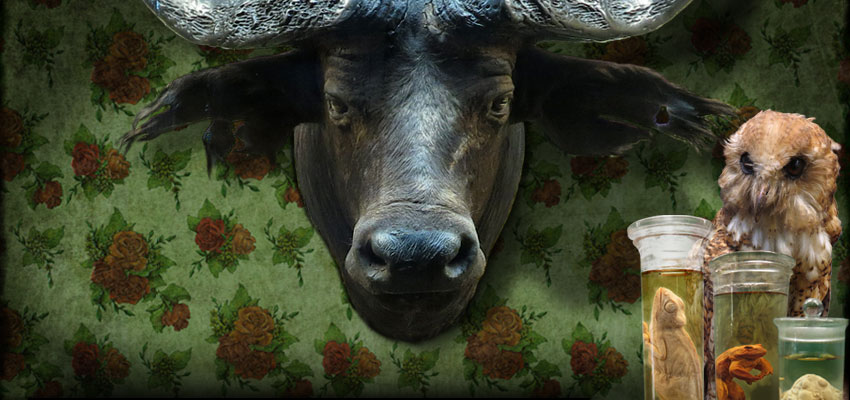Taxidermy and Natural History
The art of preparing, preserving, and mounting the skin, hair, feathers, or scales of animals in a life-like position for study and classification or display is called taxidermy. I do not intend to give an overview of the history of taxidermy, this website is designed to reflect my natural history interests and links to articles on taxidermist, including Rowland Ward, Carl E. Akeley, Water Potter and taxidermy sites.
The interest in the exotic and rare from foreign lands expressed itself in the desire for collecting and preserving. The study of natural history and collecting gave rise to the Cabinets of Curiosities or ‘Wunderkammers’ of the Renaissance, which were filled with fantastic displays of curiosa. The cabinet collections, a worthy interest of wealthy gentlemen, were designed not only to delight and to extend man's knowledge of strange new worlds, but also to show the collector's position and prestige. Taxidermy originated as a means of preserving rare, strange, exotic and wondrous products of nature.
Many of the early European natural history museums had their origins in these cabinets of curiosities. When confronted with the study of natural history and museum displays of taxidermic animals, we may find ourself wondering about the death of the animal rather than looking for greater meanings as to what it represents and why it was used. The study of naturally history changed dramatically when the photographic medium emerged, the focus shifted from the ordering and classification of dead animals to studying the animal's living behavior in their natural environment. Museums responded by adding new naturalistic settings for the animals through habitat dioramas, which allowed the viewers a virtual experience of being in a particular place viewing the animals that lived there as in life.
Our changing awareness of nature and wild life, control on wild life trade and wild life protection has made taxidermy a controversial and challenging subject, but it must also be seen and recognized as being a major and very important part of the world-wide cultural heritage, which still informs us about the historical practices and perspectives common in the Victorian era.
Rowland Ward: Taxidermist to the World
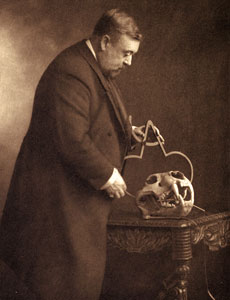
Rowland Ward (1848–1912) was a famous, innovative and world renowned taxidermist whose shop at 'The Jungle, Picadilly' at the end of the 19th Century became a social institution for sporting enthusiasts. The company specialized in, and was renowned for, their work on big game trophies, but their output covered all aspects of taxidermy. Taxidemist to Big Game Hunters of a previous era and regarded by many as the finest British historical taxidermist of his time.
Author P.A. Morris has spent many years collecting material on Rowland Ward and his taxidermy, his book, entitled Rowland Ward: Taxidermist to the World (2003) attempts for the first time to put on record the work of Rowland Ward as a tribute to him and to those who worked for the Company that he founded.
Rowland Ward died in 1912, but his name lived on, synonymous with high quality and big game taxidermy. Countless hunting trophies, glass cases and articles of ‘animal furniture’ carry one or more of his familiar trade labels. For over a century, the firm that bore his name was the market leader, at a time when taxidermy was an integral part of the science of natural history. Taxidermy was also associated with many aspects of the social history of the nineteenth and twentieth centuries, ranging from sporting activities in the Empire to the household decorations in middle class Victorian and Edwardian homes. Rowland Ward and the business he founded were at the forefront.
The products of Rowland Ward Ltd. are familiar to museums, collectors and big game hunters throughout the world, but seeking details of Ward himself, or the leading firm that he established, is often frustrating and fruitless. Yet it is increasingly recognised that taxidermy and the scientific preservation of animals form an important part of the history of natural history, inviting curiosity about one of the most famous contributors in this area.
Rowland Ward links
- Rowland Ward Taxidermists at The Royal Museum of Central Africa - Tervuren
- La taxidermie londienne au service des premiers dioramas française
- Rowland Ward.com
- Historical Victorian Taxidermy
Walter Potter
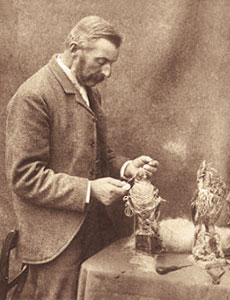
" Dear Mr. Walter Potter,
I am going to tell you what I want for Christmas. I am a good little girl of 5 years old. Please make the house that Jack built with the malt, the rat, the cat and the dog that worried the cat.
Your friend, Mary "
Walter Potter (2 July 1835 – 21 May 1918), was an English taxidermist famous for his bizarre anthropomorphic tableaux featuring various mounted animals imitating human life and leisure.
A taxidermist of no great expertise, but a true artistic genius, who dreamed up a fantasy world in taxidermy and brought it to life. In addition he was a skilled model maker, crafting props and painting scenic backdrops for his cases with fervent attention to detail.
Some of the scenes he depicted were inspired by nursery rhymes, such as "The House That Jack Built" and "The Death and Buriel of Cock Robin", showing the funeral procession to the churchyard with the parts all played by his stuffed animals and. "The Babes In The Woods", is a traditional children's tale, as well as a popular pantomime subject of two children abandoned in a wood, who die and are covered with leaves by robins.

Other tableaux feature animals engaged in human activity, they include rabbits attending class at The Village School. The Guinea Pigs' Cricket Match and Band. The Kittens' Tea Party displays feline etiquette and a game of croquet. The minor tableaux include the Sporting Party, the Happy Family, the Athletic Toads enjoying a sunny afternoon in the park running and jumping. The Upper Ten depicting the squirrel's social club in contrast to The Lower Five, which shows the rat's drinking and gambling den raided by the police.
The Kittens' Wedding was Potter's last masterpiece and most popular scene, completed in 1890, and the only tableau in which the animals are dressed. The bride wears a white brocade dress and a long veil, a cat as parson and six bridesmaids in brocade dresses, complete with tiny prayer books, golden rings and frilly nickers.
Apart from his anthropomorphic representation of animals, he had also mounted examples of deformed animals such as two-headed kitten with four eyes and four-legged chicken donated by local farmers.
By 1880 his curious collection expanded into a museum known as “Mr Potter’s Museum of Curiosities” an important attraction for the tiny village of Bramber, and came to be housed in a separate museum building on land next to his father's the inn. Here he welcomed visitors, received donations of small game from local farmers, and steadily improved his displays.
In 1972 the Museum was sold and relocated to Brighton and two years later to Arundel, in Sussex. In 1985 it was sold again and moved to the Jamaica Inn in Cornwall. The collection was finally dispersed in an auction sale in 2003.

Further reading
Walter Potter and his Museum of Curious Taxidermy"- by P.A. Morris
An extraordinary historical work that examines the curious collection and work of Walter Potter.
Professor P.A. Morris explores the culture and world that surrounded Potter. Full-colour illustrations of unique works and artifacts.
This is a marvelous and beautiful book, a true treasure!
Walter Potter Links
Mr Potter of Bramber Sussex
- Mr Potter of Bramber - The Steying Museum
- The Curious Taxidermy Of Walter Potter
- A Case Of Curiosities - Walter Potter Inspired by Hermann Ploucquet
- A Case Of Curiosities - Hermann Ploucquet
- Walter Potter's Museum of Curiosities
- Walter Potter's Curious World of Taxidermy
British Pathe - Vintage TV
The Sale of the Contents of Mr Potter's Museum of Curiosities Sep 2003
Articles on Walter Potter
- Animal magic by Pat Morris - The Guardian 2007
- Coilhouse Blog Walter Potter
- Walter Potter's Museum of Curiosities - Mail Online 2010
- Genius or grotesquery? The arrestingly strange world of Walter Potter - The Guardian 2010
- Walter Potter - Kittens getting married and bunnies at school - The Daily Mail! - 2013
The Death and Burial Of Poor Cock Robin
- The Death of Cock Robin. Published 1819 by Printed by J. Fairburn
- H. L. Stephens illustrations for Death and Burial of Poor Cock Robin, circa 1865
Where Kittens Wed and Birds Lament - Trailer 01 - The Midnight Archive
Carl Ethan Akeley
Akeley was driven, he tells us, by wanting to preserve the animals before they vanished in the wild. It seems a strange motivation for killing and mounting them, and yet it also seems apparent enough in his work that the feeling was genuine.
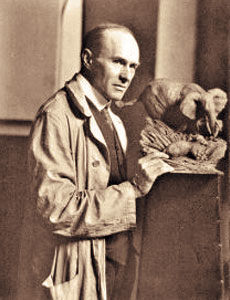
Carl Ethan Akeley (born May 19, 1864, Clarendon, N.Y., U.S.—died Nov. 17, 1926, Albert National Park, Belgian Congo). A man of many talents was an American naturalist, artist, taxidermist and explorer who developed the taxidermic method for mounting museum displays to show animals in their natural surroundings. He was widely known for his innovations in taxidermy and diorama design. His method of applying skin on a finely molded replica of the body of the animal gave results of unprecedented realism and elevated taxidermy from a craft to an art. His modeling led to sculpture, and he executed notable pieces showing elephants, lions, and lion spearers. Akeley’s goal was to create a panorama of Africa and its big game in American museums.
At age 19 he became an apprentice at Ward’s Natural Science Establishment in Rochester, N.Y., and during his associations with the Field Museum of Natural History in Chicago (1895–1909) and the American Museum of Natural History in New York City (1909–26) he made five trips to Africa to study, hunt, and collect big game.
In 1923 his book "In Brightest Africa" appeared. He was also an Inventor and an active gorilla conservationist. He was among the first to accurately document mountain gorillas as intelligent and social animals that, even then, were under grave threat from overhunting. His research inspired him to dedicate the last few years of his life to the conservation and protection of the mountain gorilla. Akeley convinced King Albert of Belgium to set aside 200 square miles that would be their sanctuary, creating Africa’s first wildlife sanctuary in Africa, which today lies in the Democratic Republic of the Congo. He died during his last expedition and was buried on Mount Mikeno in Albert National Park (now Virunga National Park, Congo). His inventions include the Akeley cement gun, used in mounting animals, and the Akeley camera, a motion-picture camera adapted for use by naturalists, with which Akeley made the first motion pictures of gorillas in their natural habitat.
Carl Akeley and The Field Museum
Carl Akeley, considered the father of modern taxidermy, was not only a taxidermist, but also a naturalist, sculptor, writer and inventor. Over his long career he worked for several different museums, including the Field Museum from 1896 to 1909 as Chief Taxidermist. He made a total of five expeditions to Africa to capture its beauty and bring back specimens for display. His famous piece, the Fighting African Elephants, is still on display in Stanley Field Hall. A man of vision, Akeley’s dream was to “give a dignity and fineness to taxidermy which should lead men of great genius to be attracted to it.” - The Field Museum

Carl Akeley - The Field Museum
- About Carl Akeley
- The Sculpture of Carl Akeley - Natural History Bulletin 1980
- Carl Akeley as Naturalist, Taxidermist, Inventor - Natural History Bulletin 1980
Carl Akeley and The American Museum of National History
Akeley was an autodidact who taught himself taxidermy out of a textbook, which prepared him for a position in 1884 with Ward's Natural Science Establishment in Rochester, New York.
In 1886 Akeley moved to the Milwaukee Public Museum, where he created-in 1889-what is considered to be the first habitat diorama for a science museum. From there he took a position with the Field Museum in Chicago, which sent him on his first expedition to Africa in 1896.
For the Field Museum, Akeley mounted "The Charging Bulls," its well-known elephant display, and also "The Four Seasons" (1902), the first habitat group display in a science museum to feature large mammals (white-tailed deer) set before a painted background.
Akeley started at the AMNH in 1909, and was again sent to Africa to collect elephant specimens. In Kenya, he was nearly killed by a charging bull elephant, and while convalescing, dreamed of creating a hall at the AMNH dedicated to depicting the splendor and beauty of the vanishing African wilderness.
Akeley returned to Africa in 1921 to collect gorillas, and based on his experiences during his trip, became an advocate for their protection, being instrumental in the creation of a preserve to protect them. Akeley's final expedition to his beloved Africa was in 1926, where he fell ill and died. He was buried at the site featured in the gorilla diorama in the Museum's Akeley Hall of African Mammals, which was named in his honor. - AMNH
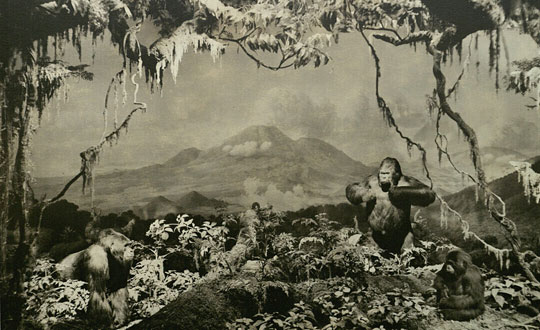
Carl Akeley - AMNH
- AMNH - Finding the Site of an Iconic Museum Diorama.
- AMNH TV
- The Akeley Hall of African Mammals
- Stephen C. Quinn Revisiting Akeley's Gorillas
- Stephen C. Quinn author of Windows On Nature
- ANMH Research Library Photo Collection
Mounting the Indian Elephant - AMNH
Mounting the Indian Elephant (shown here in abridged form) is a 1927 silent film that documents Carl Akeley's taxidermy process from the raw hide — fresh from the Faunthorpe-Vernay collection expedition — to finished display.
Carl Akeley The Writer
"In Brightest Africa" - by Carl Akeley (1923)
Adventures in the African big game country gathering specimens for the American Museum of Natural History and was in Africa at the time of Theodore Roosevelt's famed safari.. Truthfulness is the high note of the enduring biographer of animal life as well as of human life.
"Lion spearing" - by Carl Akeley (1926)
The story of African Nandi warriors who hunted lions with spears. The plates depict the life-size bronze sculptures by Akeley, of such a lion hunt, now on display in the Chicago and New York Natural History Museums.
"Taxidermy And Sculpture: The Work Of Carl E. Akeley In Field Museum Of Natural History" - by Carl Akeley (1927)
Field Museum, Chicago, 1927. Illustrated with 48 loose photogravure plates. 9" x 12". 3 pp text. Loose plates in a simple folder, housed in a printed paper covered slipcase. Reproductions of Akeley's big game taxidermy and sculpture, 1894 to 1924, including full mount specimens of Stone sheep, musk ox, polar bear, Virginia deer, wild ass, zebra, kudu, antelope, gazelle, waterbuck, gnu, hartebeest, sassaby, bontebok and other horned game, Cape buffalo, warthog, cheetah, hyaena, proboscis monkey, elephant, with bronze sculptures of elephant, lion, gorilla, etc., including his "Lion Spearing In Africa" sculptures, and a full length portrait of Carl Akeley. A nearly complete representation of Akeley's work as it now exists in the Field Museum.
"Adventures In The African Jungle" - by Carl Akeley (1930)
Written by Carl and Mary Akeley. Mary Jobe Akeley, Carl's second wife, selected segments from her husband's In Brightest Africa , including the near death experience incident in which he was pinned by an elephant. In addition, she includes passages from his diary relating hunts after buffalo and elephant in Uganda.
"Lions, Gorillas And Their Neighbors" - by Carl Akeley (1932)
The tale of his last adventure in the wilds of Africa alongside his wife and co-author includes his securing of the first ever motion pictures of gorillas, his experience of killing a leopard with his bare hands and the spectacle of lion-spearing.
Carl Akeley - Open Library
- "In Brightest Africa" by Carl Akeley (1923)
- "Lion spearing" by Carl Akeley (1926)
- "Hunting The African Buffalo" by Carl Akeley, American Museum Journal (1915)
Carl Akeley The Inventor
Akeley's Pancake Camera
Carl Akeley's contribution to the Motion Picture industry was the “Akeley” 35mm Motion Picture camera that was small, tough and efficient to withstand the rigors of wildlife filming. Explorer-filmaker Martin Johnson used the camera in his dramatized wildlife films, most notably Simba (1928), which included lion-spearing footage shot by Akeley himself, and Congorilla (1932).
Wild Film History: Martin Johnson and Carl Akeley's camera cars meet in Tanganyika, during filming for Simba (1925).
- SIMBA: The King of the Beasts (1928)
- Spearing 'a roaring comet of wrath' (video clip)
- Osa Johnson training assistant camermen (video clip)
- Filming an ancient elephant trail (video clip)
- Martin and Osa Johnson’s SIMBA SAGA OF THE AFRICAN VELDT (Press Kit Milstone Film)
- Congorilla (1932)
Akeley invented the cement gun for use in his own work
About Carl Akeley
Natural History Magazine - ebook
- Natural History - "Carl Akeley Again Penetrates the African Jungle" . Vol 21, 1921
- Natural History - Akeley Memorial Number. Vol. 27: 2, March-April 1927
- Natural History - Glimpses Into the African Hall. Vol. 37, January 1936
Jeannette Eileen Jones - University of Nebraska
- In Brightest Africa: Naturalistic Constructions of Africa in the American Museum of Natural History, 1910-1936
- Gorilla Trails in Paradise: Carl Akeley, Mary Bradley, and the American Search for the Missing Link
More ...
- Master Taxidermist and Hunter
- Pictures of Akeley's work Flicr
- Bonhams - "The Wounded Comrade" by Carl E. Akeley (1864-1926)
